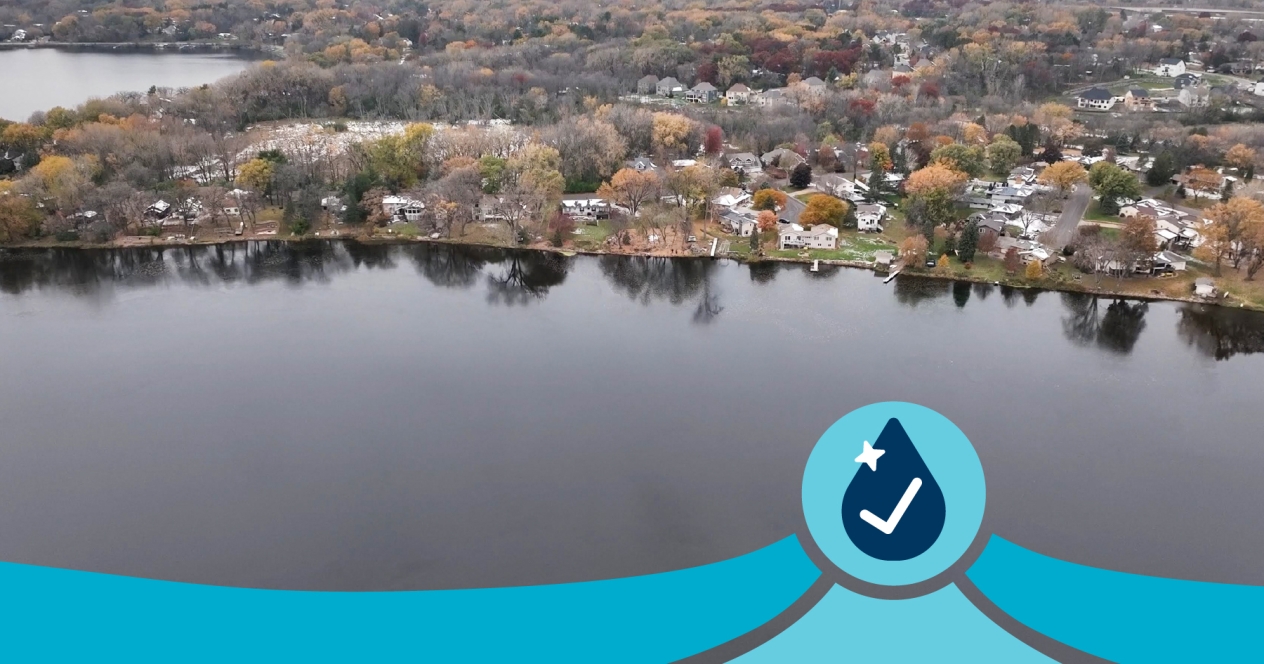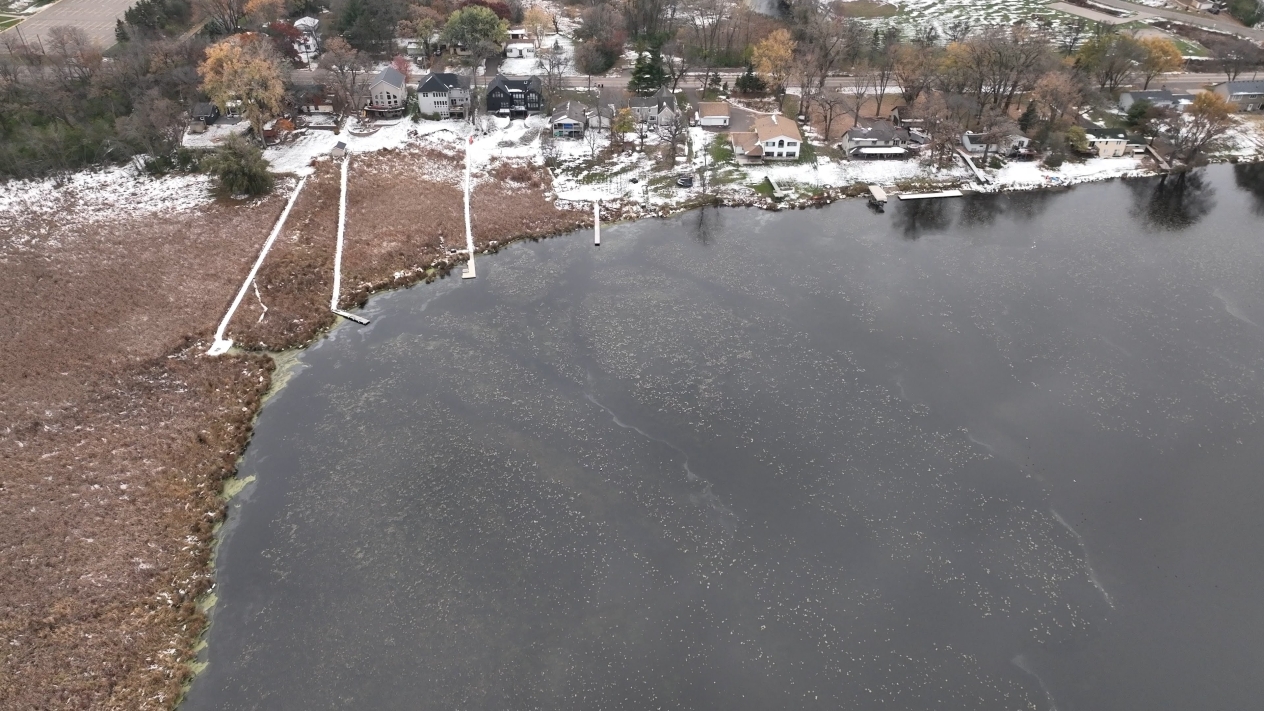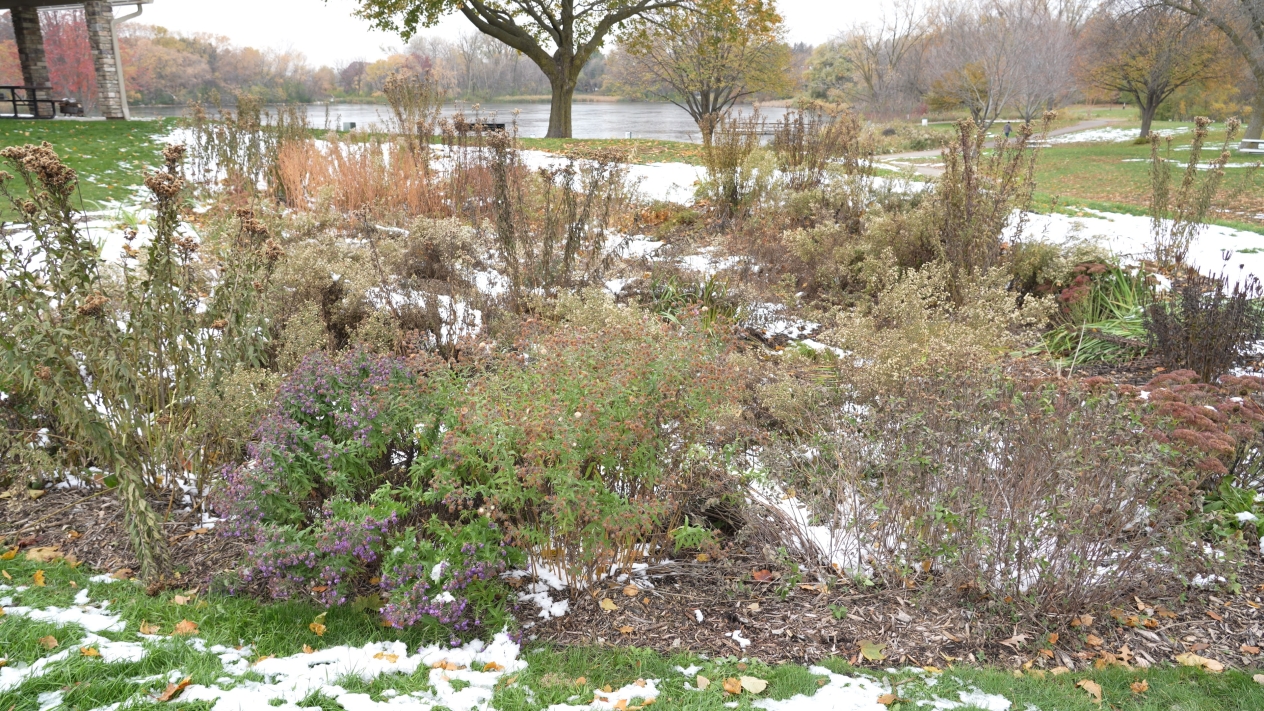
Kohlman Lake is one of several to come off the state’s impaired waters list this year
A thin crust of ice covers much of Kohlman Lake after a week of chilly nights. It reflects the low cloud cover overhead and amplifies the calls of waterfowl flying over the wetlands by the lake’s southeastern corner. The ice holds in its grip the grasses and reeds that rim the lake, duckweed in some pools along the shore, and scatterings of lily pads in the shallows.
Standing on the shore of the lake this late in the season, there’s no sign of the mats of invasive curly-leaf pondweed that often choked the lake in the past. Nor do algal blooms spread across the surface of the water in a sickly green smear. And both are expected to continue to recede from Kohlman Lake in coming years as the lake responds to the more than two decades’ worth of efforts to clean it up.
“Kohlman Lake is a good story about all the ingredients that had to go into this recipe to succeed,” says Paul Gardner, the administrator of the Clean Water Council. “It’s useful to tell that story because it does show how hard it is and how long it takes, but it is possible.”
A problem with pondweed
The lake itself only covers about 74 acres. It’s small by comparison to many Minnesota lakes. It’s shallow, too; with an average depth of about four feet, an average-sized adult could walk across much of it. Aside from the wetlands, only suburban lawns and private docks occupy the shoreline. Anybody not living next to it would have a difficult time accessing the lake.
Water, however, has no problem making its way to Kohlman Lake. Creeks and drainage ditches direct rain and stormwater runoff to the lake from parking lots and roads and lawns across a 7,484-acre watershed that spans seven cities in eastern Ramsey County.
As that water trickled in to Kohlman Lake over the years, it brought with it whatever it picked up along the way, including plenty of sediment. Hitching a ride on that sediment was an overabundance of nutrients, primarily phosphorus, which turned the lake’s ecosystem upside down. Curly-leaf pondweed took up the phosphorus and began to dominate the lake, as did algal blooms and another invasive plant species, Eurasian watermilfoil. An overabundance of carp in the lake didn’t help matters, with the fish stirring up what phosphorus had settled into the sediment at the bottom of the lake.

While the excess phosphorus didn’t directly impact the health of residents around the lake, the curly-leaf pondweed and the algae curtailed boating and swimming there. Residents had to hire aquatic plant harvesters to cut channels from their docks through the mats out to increasingly smaller patches of open water. According to one report, residents described the pondweed and algae as “bobbing expanses of green steel wool.” And with Kohlman Lake emptying into a chain of lakes with Lake Phalen at the end, Kohlman’s problems were sure to spread.
The lake needed help, and nothing proved that point more than when the Minnesota Pollution Control Agency added the lake to the impaired waters list in 2002.
The Clean Water Fund’s role
While many factors and many pollutants can and do lead to the MPCA’s decision to add lakes, rivers, and streams to the impaired waters list every other year, not all of them are necessarily detrimental to human health.
“People see the list and they think it means that those waters are off limits and they're usually not,” Gardner says. “You could have swum or fished in Kohlman Lake, but it was not going to be the greatest experience of your life.”
Under the federal Clean Water Act, every two years Minnesota and every other state must produce a list of all the lakes, rivers, and streams that fail to meet water quality standards. Those standards cover everything from bacteria that can make the water unsafe for swimming to sediment that can prevent fish from spawning to mercury, PFAS, and other pollutants that can harm people’s health.
The Clean Water Fund came about in the late 2000s when the Minnesota Legislature took note of the state’s growing impaired waters list and put on the ballot the Clean Water Legacy Amendment, which raised sales taxes in the state by 3/8 of a percent and set aside a portion of that funding to pay for water restoration and protection projects. Voters then approved the plan in 2008.
“The Clean Water Fund is not used for random acts of conservation,” Gardner says. “There is a science-based and watershed-based approach to addressing our impaired waters.”
To do so, the fund’s administrators set aside 15% of its now $160 million annual budget for developing the impaired waters list as well as monitoring and assessment to figure out how to best spend the rest of its budget. From that monitoring and assessment data, the MPCA develops a Watershed Restoration and Protection Strategy (WRAPS), essentially a big to-do list, to assist local water managers in prioritizing projects that will get that body of water off the impaired waters list. In the metro area, watershed districts and water management organizations will put together similar strategies and seek Clean Water Funds to complete them.
If, for instance, the WRAPS or local watershed plan for a lake specifies a reduction in phosphorus of 50 pounds per year and suggests an individual project that can reduce phosphorus by 12 pounds per year, Gardner weighs that benefit against the cost of the project.
“We’re not going to pay a million dollars per pound of phosphorus reduced, but $5,000 is not an uncommon number,” he says.
A 25-year restoration
According to the Ramsey-Washington Metro Watershed District, restoration of Kohlman Lake began in the late 1990s with the stabilization of the banks of Kohlman Creek and the installation of weirs in Kohlman Basin, a low-lying area just to the east of the lake. Over the next decade, the district also installed in an area just north of the basin an iron-enhanced sand filter designed to remove 90% of the phosphorus in the stormwater headed toward Kohlman Lake.
Those projects helped bring phosphorus levels in the lake down from a high of 171 micrograms per liter, as measured in 1982, to 98 micrograms per liter by the late 2000s. While a substantial reduction, the lake's phosphorus levels still needed to come down to 60 micrograms per liter, the target amount for MPCA staff to consider the lake healthy enough to come off the impaired waters list.
With the Clean Water Legacy Amendment in place, the Clean Water Fund could then start to contribute to that goal. Rather than scrub the waters entering Kohlman Lake, the projects made possible by the Clean Water Fund and other locally raised funds focused more on reducing the amount of water running directly from paved surfaces in the area to the lake.

In total, the Clean Water Fund distributed $2,341,000 in grants over the last decade toward dozens of projects. They helped the Maplewood Mall retrofit its expansive parking lot with tree trenches, rain gardens, and permeable pavers. They put 14 rain gardens around Casey Lake. They funded more rain gardens at several churches in the vicinity, including one about half a mile away on the far edge of the Kohlman Lake watershed.
Gardner notes that those projects are all in addition to other efforts by the MPCA, watershed districts, and soil and water conservation districts to minimize the amount of nutrients reaching lakes like Kohlman statewide.
“This watershed district is also a big advocate for getting their municipalities to do better street sweeping techniques — if you have a big tree canopy in your city, you actually can reduce phosphorus at a really low price per pound by just using the right piece of equipment at the right time,” he says. “And of course, we have better stormwater regulation too, I don’t want to minimize that. Every time anybody builds something new in the Kohlman Lake watershed, the developer likely must improve practices to catch stormwater.”
Impaired waters list as a tool
Appearing on the impaired waters list doesn’t necessarily mean restoration of that body of water is inevitable or that the path toward restoration will be paved with unlimited grants from the Clean Water Fund.
“The impaired waters list is a diagnostic tool, it helps us figure out where to focus our efforts with finite resources,” Gardner says.
He likens it to a pass/fail test for which the only way to pass is to get a perfect score on more than 30 standards.
“A body of water can improve its score over time, but might still be considered impaired,” he says. “It doesn’t always reflect all the improvement going on.”
Nor does a quick review of the sheer numbers of lakes, rivers, and streams going on and off the list tell a complete story. As Gardner points out, the Clean Water Fund helped pay for 10% of the state’s waters to be tested for impairments each year for the last 10 years.
The data from that effort caused the MPCA to label many more waters across the state impaired, which “really bulked up the list,” says Leya Charles, a research scientist with the MPCA. “So now we’re going to start revisiting those sites to see how they compare, and we expect to see most of them hold steady or improve in quality.”
In the case of Kohlman Lake, Charles said it took reports from more than half a dozen monitoring programs from the last several years — including programs by the MPCA, watershed district, Metropolitan Council, Ramsey County Public Works, and a volunteer lake monitoring program — to contribute enough data to warrant removing the lake from the impaired waters list.
Gardner says he actually expects the rate of de-listings to accelerate in the coming years as restoration and cleanup projects already underway start to show results and as water managers apply what they’ve already learned about getting the best bang for their buck when it comes to cleaning up Minnesota’s waters.
“The thing that is empowering is that we now know how to prioritize, target, and measure our efforts,” he says. “We can do things in a more comprehensive way, and it keeps the decision making based on science.”
